Calculator for Estimating the Risk of Pulmonary Oxygen Toxicity
Posted by Barbara Shykoff | September 24, 2018
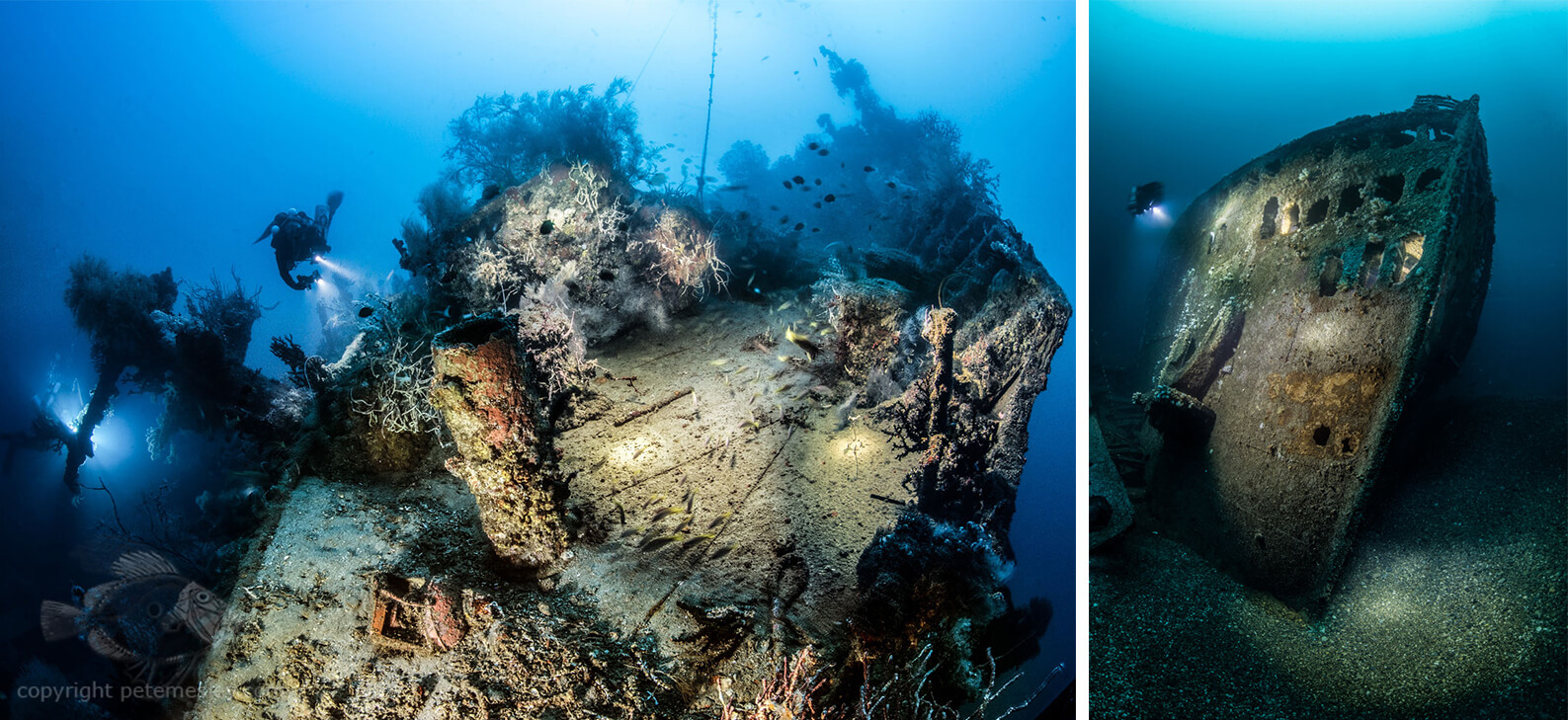
A calculator to estimate the risk of pulmonary oxygen toxicity after repeated dives with oxygen partial pressure of 1.3 bar
The oxygen partial pressure (PO2) set point for a number of diving rebreathers is 1.3 bar (1.3 atm, 130 kPa), a PO2 associated with a low risk of central nervous system oxygen toxicity. However, long or repeated dives at this PO2 may cause pulmonary (lung) oxygen toxicity. A calculation tool, previously published,1 is presented here for this PO2 to assist in planning repeated dives with a user-selected risk of pulmonary oxygen toxicity.
The model behind the calculations, based on more than 1350 in-water person-dives with PO2 = 1.3 to 1.4 bar, predicts how likely it is that someone will have noticeable pulmonary oxygen toxicity after a particular combination of dives and surface intervals. A full description of it has been published.1,2
In brief, the idea is that any dive with PO2 of 1.3 to 1.4 bar begins a process of pulmonary injury. The probability of noticeable pulmonary oxygen toxicity (P[O2tox]) is extremely low when exposure to this PO2 is short, extremely high if the exposure is very long, and approximately proportional to exposure time for intermediate dive durations. The mathematical expression of this idea is called the “incidence-time model”. The linear relationship in its mid-range means that not only can one find P[O2tox] for a chosen exposure duration (Tdur), but also, that one can find an equivalent exposure time (Teq) from the incidence of measurable pulmonary oxygen toxicity in a group of divers. Teq is defined as the single exposure duration expected to yield the incidence recorded during recovery or after a series of dives with various surface intervals (SIs).
The “recovery model” was defined using values of Teq from several dive durations after recovery times. As injury heals, symptoms or signs are resolved, and Teq decreases. Teq remaining during recovery from any single exposure is called the residual oxygen time (tr) from that exposure. Later dive durations are assumed simply to add to tr. Recovery from one dive continues even during a later exposure.
Access the Oxygen Toxicity Calculator
Incidence-Time Model
The relationship between exposure duration and the probability of noticeable pulmonary oxygen toxicity was determined using pulmonary data obtained after a total of 529 single person-dives from eight distinct exposures. Pulmonary oxygen toxicity was considered to be noticeable if divers reported inspiratory burning, cough, chest tightness, dyspnea, or showed significantly reduced pulmonary flow-volume values.
The estimate of P[O2tox] was the number of divers with symptoms or changes lung flow-volume values after a particular dive profile, divided by the total number of divers exposed to that profile. The P[O2tox] values recorded after single dives are shown as a function of dive duration in Figure 1 with 95% confidence intervals.
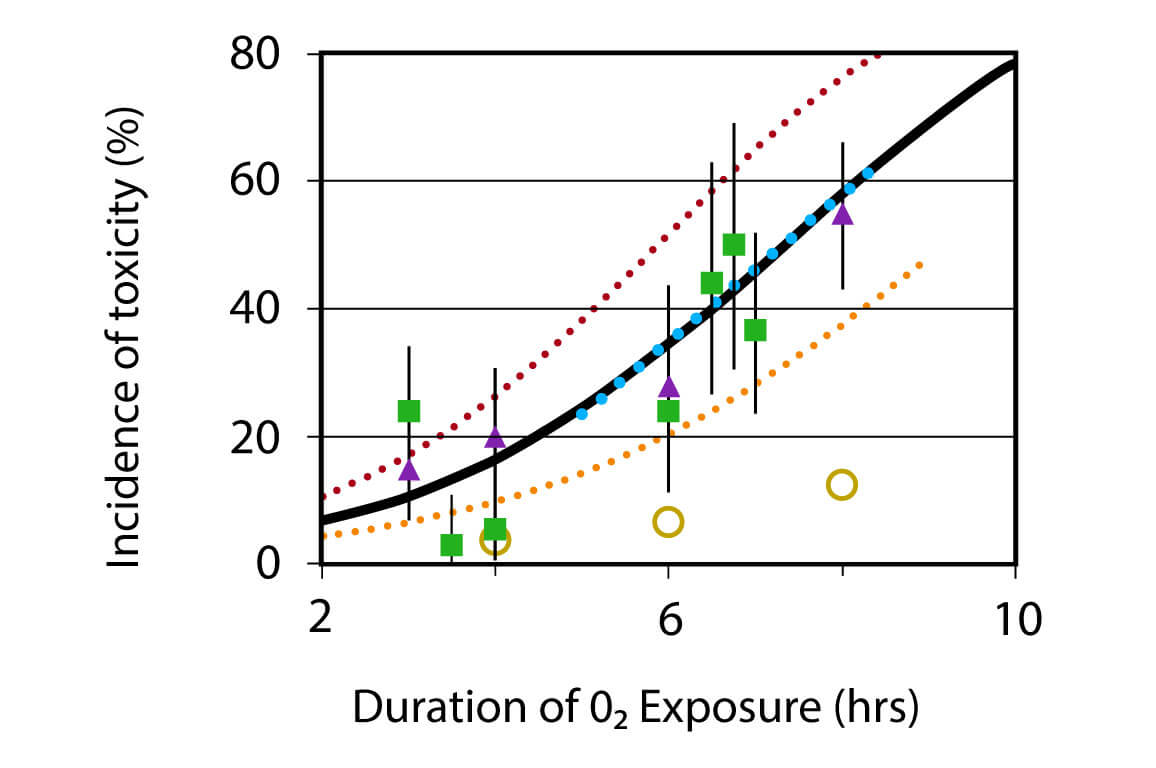
Figure 1. P[O2tox] (percentage of divers with noticeable effects) as a function of dive duration, and the corresponding incidence –time model. PO2 = 1.3 bar data: ▲ are resting dives; ■ are dives with exercise, means and Agresti-Coull binomial 95% confidence intervals. The solid line represents the logistic regression (Equation 1), and the dashed lines show one standard error on the fitted parameters. The broken portion of the regression curve is the linear range from which Teq was read from incidence. o are air dive data (PO2 = 0.3 bar). Air dive error bars are omitted for clarity.
Single resting dives and single dives with exercise (dives during which divers rode underwater cycle ergometers for 30 min of every hour) were combined in the incidence – time model. The binomial (yes-or-no) outcome of noticeable pulmonary toxicity or no noticeable pulmonary oxygen toxicity was fitted by logistic regression of P[O2Tox] against Tdur.
The fitted equation linking dive duration Tdur (and, by extension, Teq) and incidence or P[O2tox] is as follows:
| P[O2tox] (%) = 100 / [1+exp( 3.586–0.490 · Tdur )] | [1] |
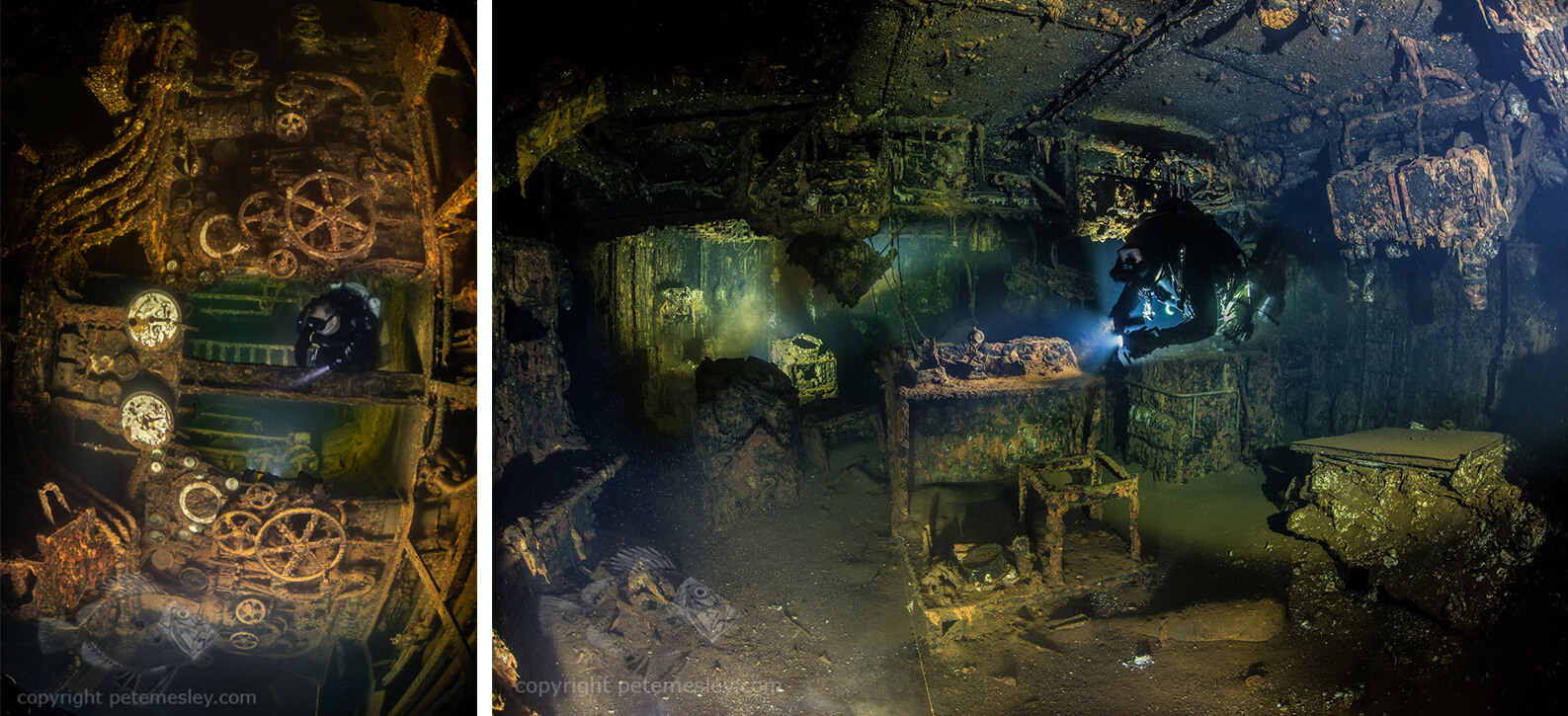
Recovery models
Determination of values
In principle, the equivalent exposure time at any stage of recovery can be found by locating the incidence of measured pulmonary oxygen toxicity on the y-axis of Figure 1 and reading the corresponding time. However, low incidences lie on the nearly-horizontal part of the curve where a small difference in assessment of pulmonary oxygen toxicity causes a very large difference in estimated Teq. The solution to this problem was to use the incidence of signs and symptoms after a second exposure when different SIs provided different recovery times from the first dive. Teq immediately after the second dive was considered to be the sum of the duration just completed and the residual time tr from the first dive, and those values of tr were used with their associated recovery times to define the recovery model.
Although P[O2tox] after a single dive did not depend on whether or not the divers exercised underwater, the rate of recovery did. From a total of 620 person-dive pairs, after resting dives, seven combinations of dive duration and SI were available for parameter fitting, and after dives with exercise, six combinations were available from the entire data set (Figure 2). The data showed that recovery did not begin immediately; no recovery was apparent after two three-hour dives separated by a two-hour SI. The model therefore includes a 5-hour delay before recovery begins. (When a second dive is planned, the 5 hours is the total of SI and duration of the second dive.)
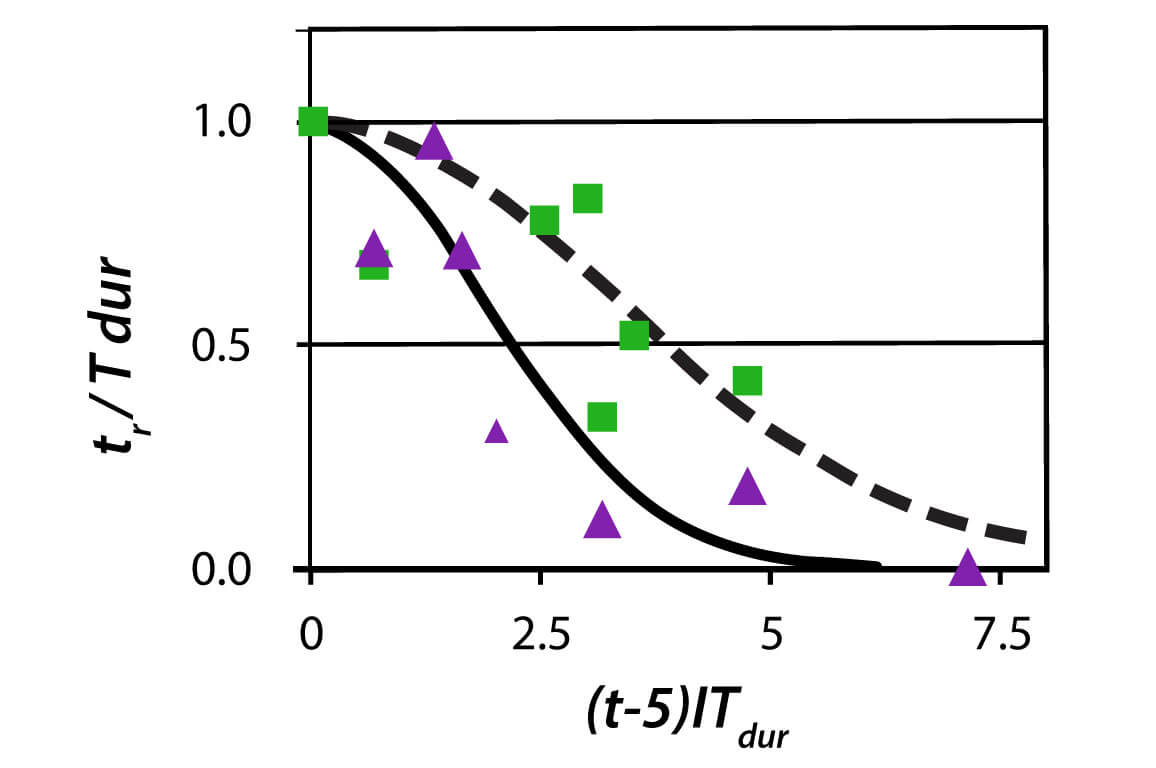
Figure 2. Values of tr/Tdur used in parameter fitting for the recovery models. After resting dives: ▲. After dives with exercise: ■. The lines are the best fit models fitted to the data: –––– for resting dives, – – – for dives with exercise, tr/Tdur = exp[–k (t/Tdur)2], k = 0.149, 0.047 for resting dives or those with exercise, respectively.
Recovery was formulated as the decrease in tr as a function of time after surfacing. The selected recovery model is
| tr = Tdur · e –f(Tdur), t > 0 | ||
| tr = Tdur, t ≤ 0, and | [2] | |
| f (Tdur) = k · (t / Tdur)2 | [3] |
where t = t – 5, five hours is the delay before the start of recovery, t is the recovery time in hours (t = 0 on surfacing), and f (Tdur) means a function of Tdur. The fitted values of coefficient k were 0.149 for resting dives and 0.047 for dives with underwater exercise.
An electronic calculator solves for the SI necessary to reduce tr to a pre-selected value for two dives, or for the risk associated with any combination of four dives and selected SIs. In both cases, any of the dives may be with rest or with exercise. The model is, of course, restricted in application to the PO2, dive durations, and numbers of dives for which data were available.
Risk for up to 4 dives
If the surface interval plus the dive following it total to less than 5 hours, dive times simply add.
PO2 = 1.3 to 1.4 atm
Inputs
Residual oxygen times (tr) from previous dives (hours)
| End of 1st | End of 2nd | End of 3rd | End of 4th | |
|---|---|---|---|---|
| From 1st dive | ||||
| From 2nd dive | ||||
| From 3rd dive | ||||
| From 4th dive |
At the end of the final dive
| Hours | hours: | minutes | |
|---|---|---|---|
| Total time in water | 0 | 0 | 0 |
| Elapsed time | 0 | 0 | 0 |
| Equivalent oxygen time (Teq) = | 0 | 0 | 0 |
| Probability of signs or symptoms of pulmonary oxygen toxicity | |||
| Probability of symptoms | |||
| Probability of change in flow-volume parameters | |||
At end of each dive
| At end of: | 1st dive | 2nd dive | 3rd dive | 4th dive |
|---|---|---|---|---|
| Teq = total from all previous dives (hours) | ||||
| Probabilities of toxicity: p(any pulmonary) | ||||
| p(symptoms) | ||||
| p(dFV), including on the next AM |
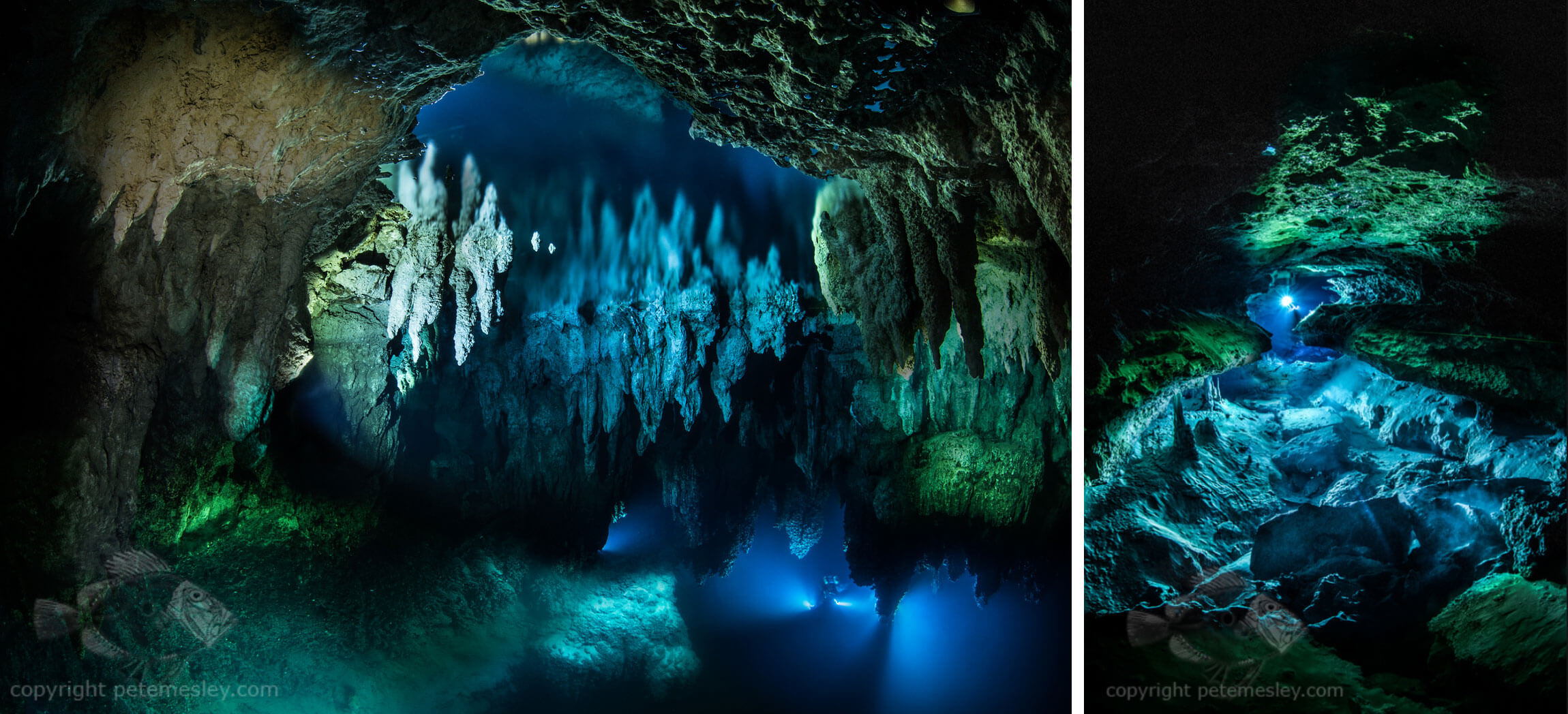
For two consecutive dives:
If the surface interval plus the dive following it totals to less than 5 hours, the equivalent time is the sum of dive times. (No recovery in less than 5 hours)
Note that the risk of pulmonary symptoms after shallow air dives is non-zero.
Inputs
Outputs
| Risk of pulmonary oxygen toxicity immediately after first dive | ||
| Risk of pulmonary oxygen toxicity after second dive alone | ||
| Risk of pulmonary oxygen toxicity with SI<5 hours | ||
| Hours | Minutes | |
|---|---|---|
| Calculated acceptable Teq | ||
| Look-up table acceptable Teq | ||
| SI |
Built into the Calculator
-
Residual and equivalent time are calculated at the end of the latest dive:
Teq = tr + Tdur (new dive).
-
The recovery time from the first dive, the dive associated with tr, is the sum of the SI and the duration of the second dive, Tdur (new dive). Thus,
tr < Tdur (first dive) if SI + Tdur (new dive) > 5 hours.
-
Tdur helps to determine the rate of recovery (Equations 2 and 3). Each component of residual time must be computed with its own Tdur, and from the end of the dive to which it relates, because the functions of time in the recovery model are squared.
Comments
-
To use time efficiently without increasing pulmonary risk, complete a shorter dive before a longer one, and a resting dive before one with exercise.
-
The rate of recovery includes the factor 1/Tdur.
-
Recovery takes almost twice as long after a dive with exercise than after one at rest. For recovery rate alone, an exercise dive is equivalent to a resting dive with the duration multiplied by a factor, [krest /kexercise]0.5 = [0.149/ 0.047]0.5 = 1.8.
-
-
The incidence-time relation does not show zero incidence at zero duration. With Tdur = 0, that is, that with no exposure to elevated PO2, symptoms or signs normally considered to represent pulmonary oxygen toxicity will be apparent in 2.7% of divers. The 95% confidence limits for this extrapolation extend from 0.8% to 4.9%. This is comparable to the overall combined incidence of symptoms or lung function changes immediately following 239 shallow open-circuit air dives with PO2 approximately 0.3 bar (Figure 1), about 6%, and could be interpreted as the effect of breathing underwater. The air dive durations were 4-, 6-, and 8-hour at rest dives and 4- and 6-hour dives with exercise. There was no statistically significant effect of duration of air dives for the data available.
-
Oher published recovery models use exponential healing because they assume first-order reaction kinetics. Healing of oxygen injury in the lungs is almost certainly a multi-step process that cannot be described by a simple chemical reaction. The sigmoidal (S-shaped) recovery pattern here was proposed based on observed values of P[O2tox]. It was selected because it fit the data better than did any exponential model tested. (Models were tested with and without delay times.)
-
Based on experimental evidence, the model treats recovery from one exposure as continuing even as injury from the next dive accumulates; experience shows that divers beginning a dive with symptoms are often (but not always) better when they leave the water the next time. Even so, diving with symptoms of pulmonary oxygen toxicity is not recommended.
-
Recovery is modeled to begin five hours after surfacing from a dive, and thus usually not to begin during the dive when the injury is incurred. Further, if a second dive ends less than five hours after the first one ended, the equivalent time is just the sum of the two durations, and P[O2tox] can be read from Figure 1 without further calculation.
-
The sigmoidal shape means that recovery rates increase to a maximum sometime after a dive, then slow again. The maximum rate of recovery occurs at (t-5)/Tdur = (2·k)–0.5, where t, in hours, is measured from the end of the dive, and k = 0.149 and 0.047 for rest and exercise dives, respectively. For example, recovery for a four-hour resting dive occurs fastest 12.3 hours after surfacing, and for a four-hour dive with exercise, 18 hours after surfacing.
-
This model attempts no association between exposure duration and the severity of pulmonary oxygen toxicity. Most effects will be mild to moderate.
-
Either symptoms or decreases in lung function values may be present without the other, but at the PO2 where this model applies, symptoms are more common than decreases in lung function values.
Caveats
-
The model is based on data with fairly high uncertainties when fewer than about 60 divers participated with the particular combination of durations and recovery times. (For binomial data, the uncertainty value includes the square root of the number of measurements in its denominator.) Further, pulmonary oxygen toxicity seems to have large interpersonal variability. (Figure 2 shows deviation of the recovery model from data used to fit it.) No guarantees are implied.
-
The model assumes that the recovery rate from one dive does not affect the recovery rate from another. This seems unlikely because the healing processes in the body must be interrelated, but the model was built on correspondence to measurements.
-
After dives, evidence of pulmonary oxygen toxicity sometimes first occurs some hours later. This model does not take that into account.
-
Exercise is treated as an all-or-nothing condition. In the model development, “exercise” was moderate cycling on underwater ergometers for 30 minutes, alternated throughout the dive with 30 minutes rest. Resting divers were either stationary or moving slowly in the pool, but without organized work. Clearly, open-water dives represent a continuum of effort from fish watching to swimming hard against a current.
-
This is a model only of pulmonary effects. Other toxic effects of long-duration, mild hyperoxia, for example, finger numbness or hyperoxic myopia, are not covered.
-
The model can be used ONLY for PO2 near 1.3 bar. To avoid extrapolation beyond the data, it should be used for single dives of durations up to 8 hours or for combinations of up to 5 dives where no dive is longer than 6 hours; the calculator is written for up to 4 dives. (One series in the data set had ten repeated 4-hour resting dives, but with a small numbers of divers.)
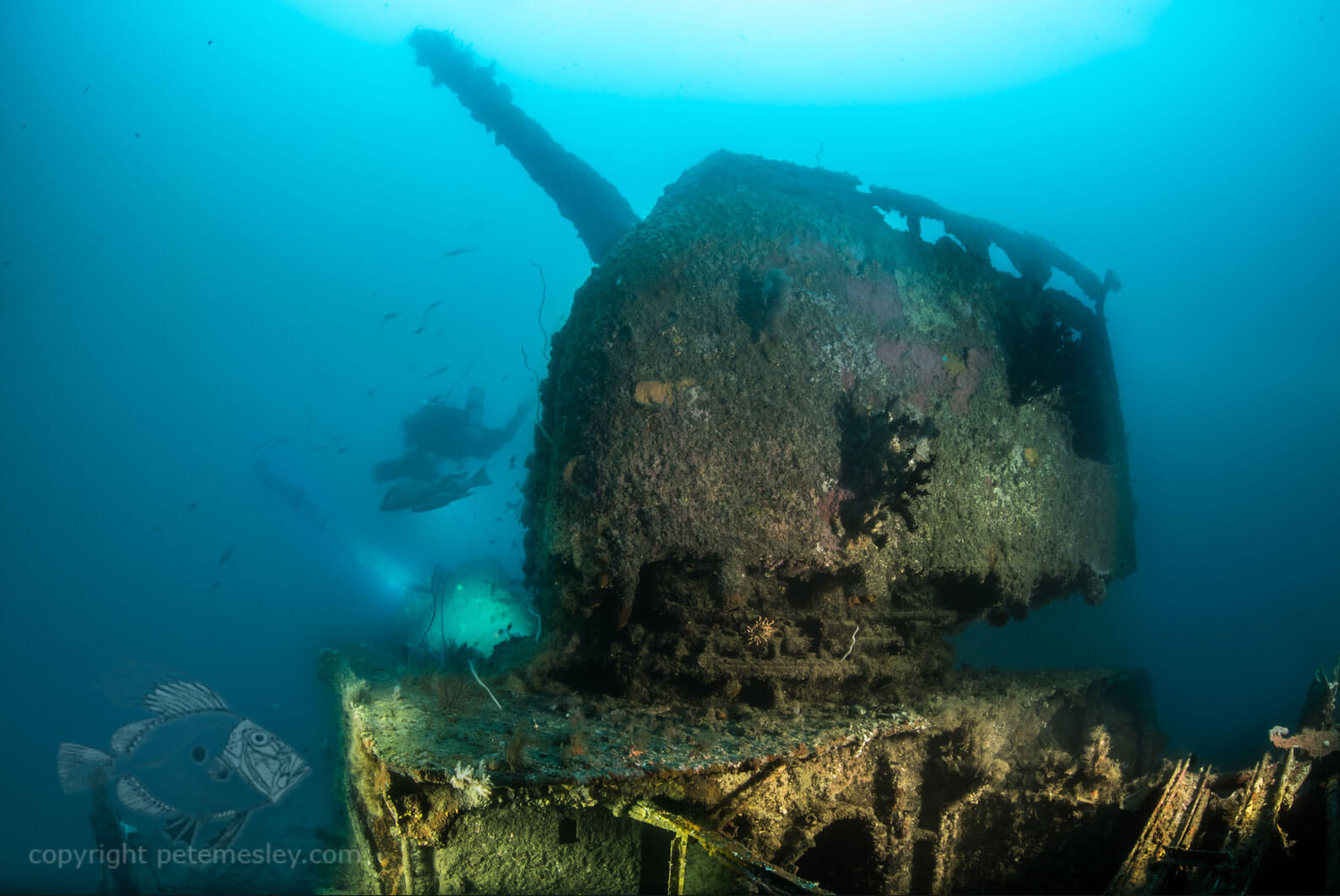
_______
-
Shykoff, BE. Development of a Pulmonary Oxygen Toxicity Risk Calculator for Repeated Dives with PO2 = 1.3 atm. NEDU TR 15 –12, Navy Experimental Diving Unit, Panama City FL December 2015.
-
Shykoff BE. Residual oxygen time model for oxygen partial pressures near 130 kPa (1.3 atm), Undersea and Hyperbaric Medicine. 42(6):547-564, 2015.
 |
Written by Barbara Shykoff
Barbara Shykoff earned her B.A.SC. (Engineering Science, Chemical option) from University of Toronto, her M.Sc.E (Bioengineering Institute) from the University of New Brunswick, and her Ph.D. (Biomedical Engineering Unit) from McGill University. For the last 16 years she has worked at the U.S. Navy Experimental Diving Unit. Her principal areas of investigation have been pulmonary oxygen toxicity, some other aspects of prolonged mildly-hyperoxic exposure, and physiological effects of breathing resistance with and without inspired CO2. |


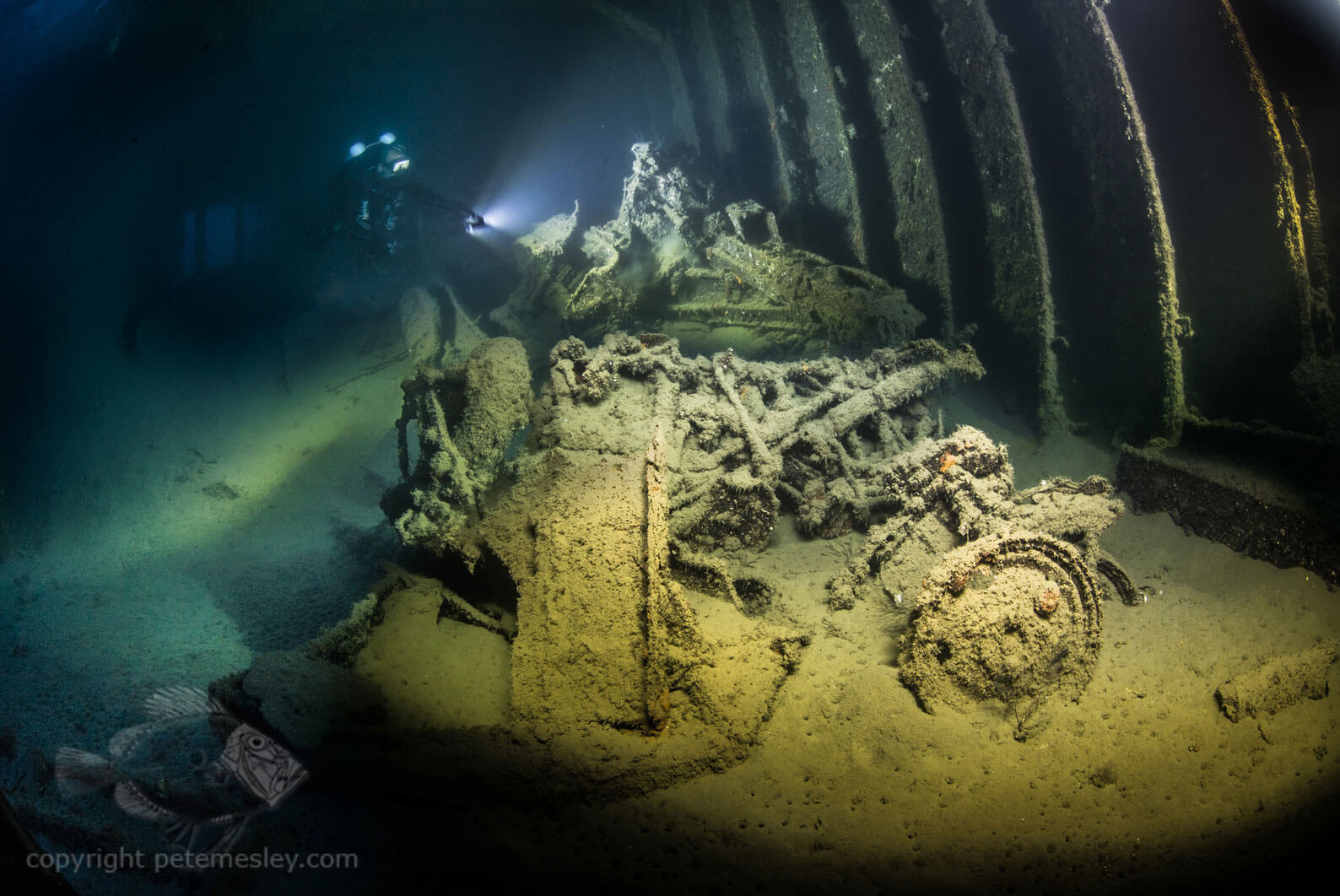
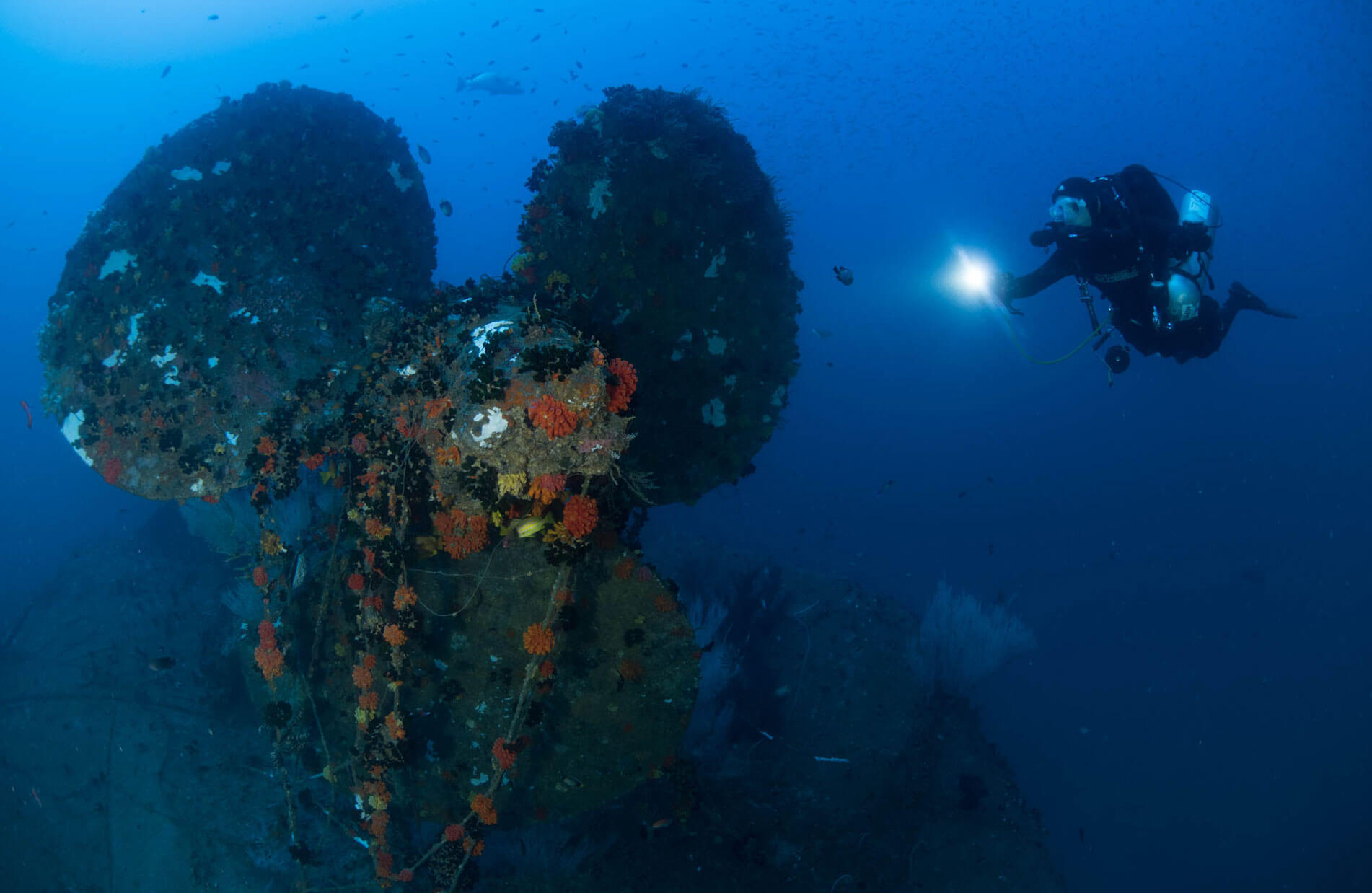
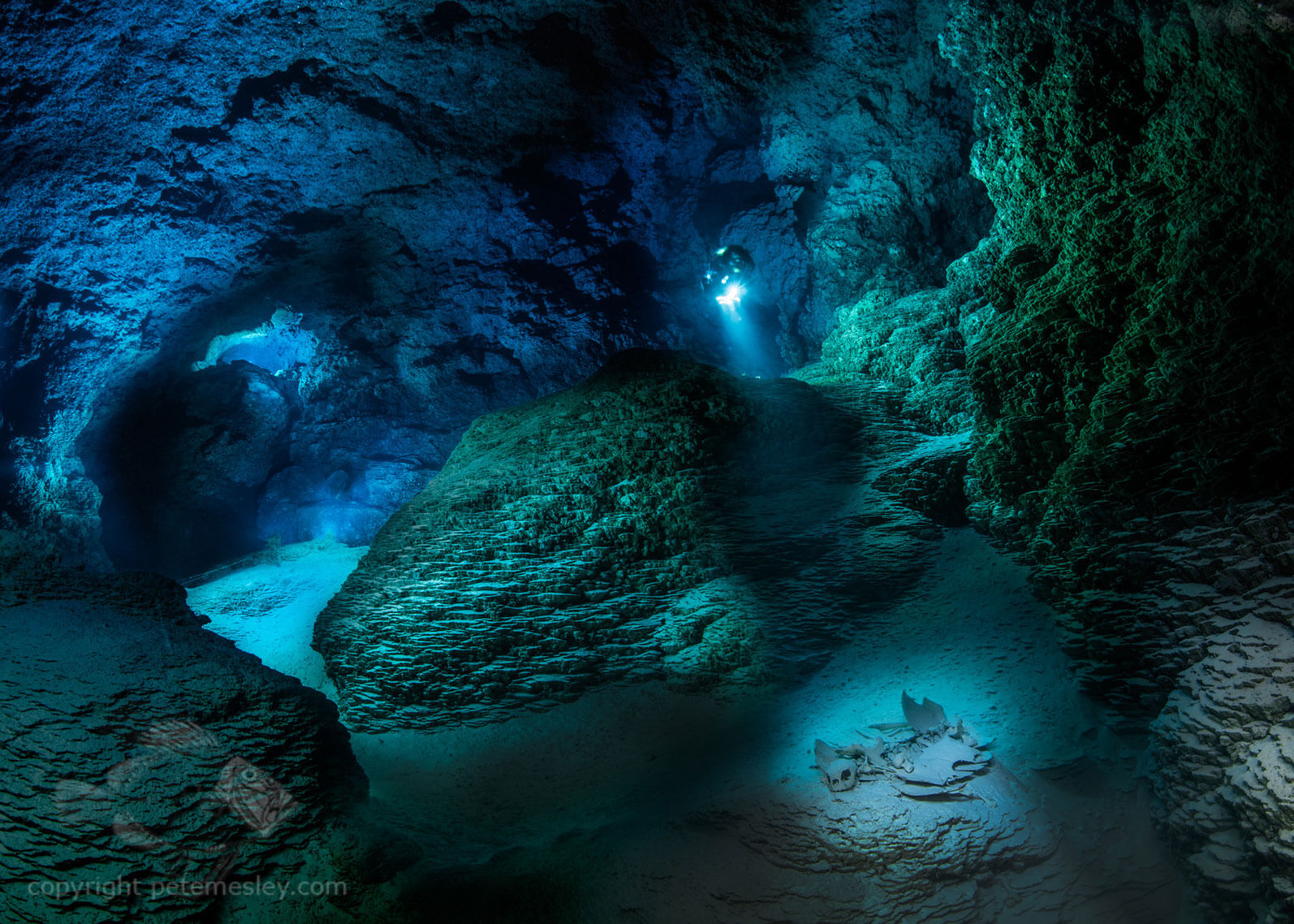
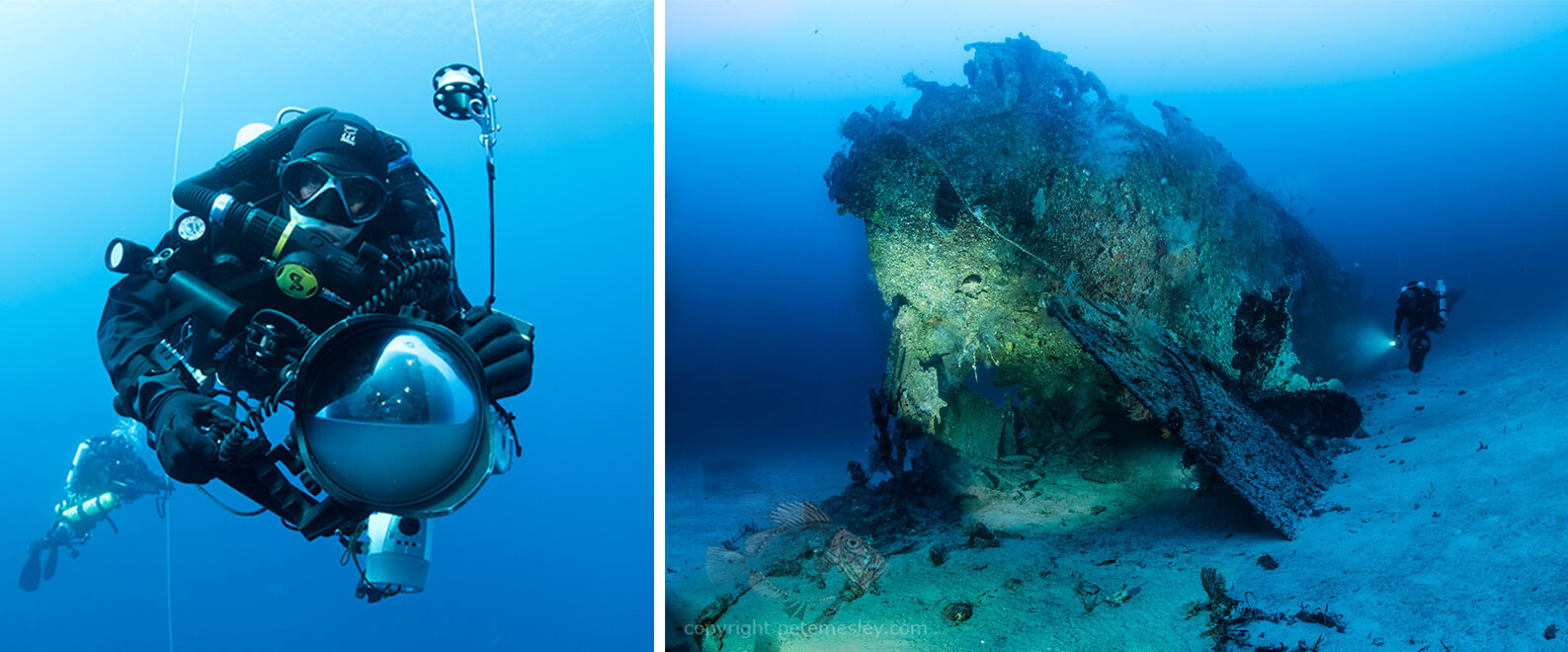
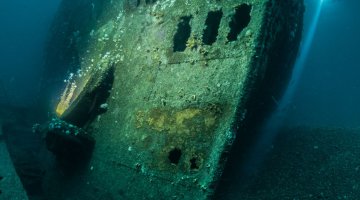
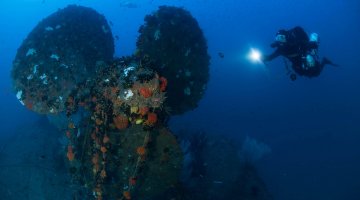
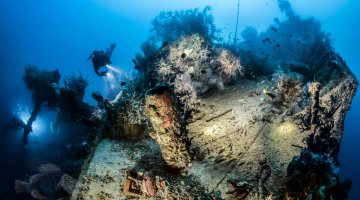

Interesting comparison. I inputted my typical weekend dive scenario where we could spend 1.5 hours in the water 2 dives per day. The results came back with a maximum of 11% Probabilities of toxicity. I also looked at the alternate dive plan of 3 1 hour dives per day. The results were the same. The controlling parameter seems to be the total exposure time under my typical dive plans. The deep plan for 60 to 100 meters involve either a single dive or at most two dives in a day. The Probabilities of toxicity was 7% and 16% respectively for first and second dives. This shows a lower risk for the deep single dive per day relative to the typical recreational dives of 3 1 hour dives per day.
Regards
Chris
Looking at the scatter plots (also in [2]) I find it quite optimistic to draw conclusions about a best fit model (I had to think of http://www.explainxkcd.com/wiki/index.php/2048:_Curve-Fitting ). Given you have standard deviations for your fit-model parameters in the appendix of [2] you should at least also give error bars for the results of your calculator. My worry would be that the scatter is almost as big as the predicted value.